1 Raise your home (add or increase freeboard)
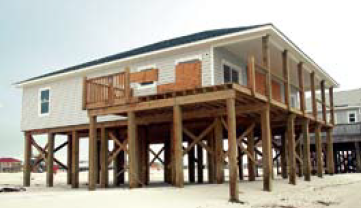
Figure. Flood elevation on pilings
One of the most effective ways to mitigate residential buildings against flooding is to raise the first-floor elevation of the buildings
above the base flood elevation (BFE, the elevation level required by most building codes) or above the historical high water mark.
In inland areas, you can increase the freeboard (feet above BFE) using pier and beams, slab on fill, or stem wall foundations. In coastal areas,
buildings must be elevated using pilings.
Estimated cost: Elevating buildings during the construction process only increases the construction cost by a
small percentage. For instance, 3 ft. elevation above BFE only increases the construction cost by about 3.56% ($8,000 for a single-family
home with 1,500 sq. ft. floor area). However, elevating existing buildings is much more expensive. Cost depends on variables such as the
level of elevation, foundation type, and number of stories. For more details on potential costs, contact a certified contractor.
2 Raise or floodproof HVAC equipment
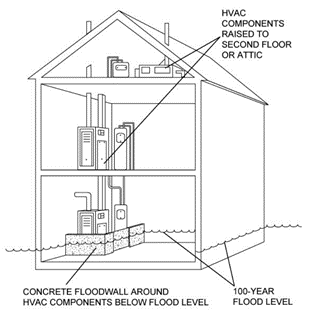
Figure. Raise or floodproof HVAC equipment (FEMA 2008)
Heating, ventilation, and cooling (HVAC) equipment, such as a furnace or hot water heater, can be damaged extensively if it is inundated by
flood waters. A good way to protect HVAC equipment is to move it from the basement or lower level of the structure to an upper floor or
even to the attic. Another option is to construct a concrete floodwall around the HVAC components
Estimated cost: Having your furnace and hot water heater moved to a higher floor or to the attic will cost about $1,500.
The cost of a floodwall will depend partly on its height and length. A 3-foot-high wall with a perimeter length of 35 feet would cost approximately
$2,500 (based on a 2008 FEMA estimate).
3 Build with flood damage resistant materials
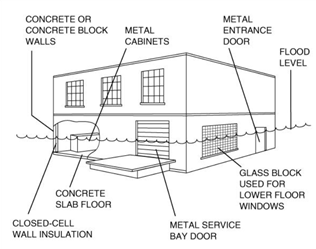
Figure. Practices for building with flood damage resistant materials (FEMA 2008)
Constructing a building with materials that are more resistant to flood damage like polyester epoxy paint or decay resistant wood can provide some protection.
4 Wet floodproofing
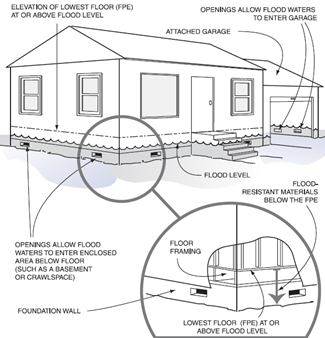
Figure. Wet floodproofing flood mitigation (FEMA 2008)
Wet floodproofing is a technique to allow flood waters easily enter and exit the enclosed areas of a house during flood events.
Flood waters inside the house can rise and fall quickly at the same rate as flood waters outside. This decreases the effects of hydrostatic pressure,
including buoyancy (when flood waters make a building float). As a result, the likelihood of structural damage may be greatly reduced. Wet floodproofing
is generally used to limit damages to enclosures below elevated buildings, walkout-on-grade basements, below-grade basements, crawlspaces,
or attached garages. It is not practical for areas that are to be used as living space. In wet floodproofing you need to make sure to:
- protect the areas of the house that are below the flood level from damage caused by contact with
flood waters
- protect service equipment inside and outside the house
- relocate any materials stored below the Flood Protection Elevation (FPE)
Estimated cost: The cost can be obtained by contacting building contractors.
5 Install sewer backflow valves
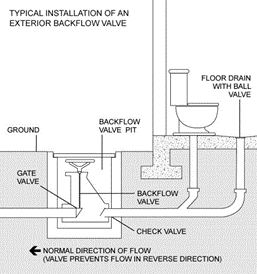
Figure. Sewer backflow valves (FEMA 2008)
In some flood-prone areas, flooding can cause sewage from sanitary sewer lines to back up through drain-pipes. A good way to protect your
property from sewage backups is to install backflow valves, which are designed to block drain-pipes temporarily and prevent return flow.
Estimated cost: Having a plumber or contractor install one backflow valve will cost approximately $1,400 for a
combined gate/flap valve or about $600 for a flap valve. These figures include the cost of excavation and backfilling (based on a 2008 FEMA estimate).
6 Raise electrical system components like outlets and switches above potential flood waters
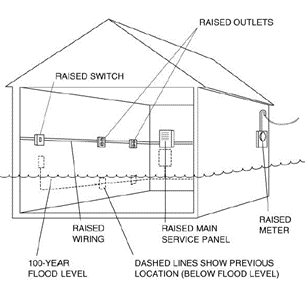
Figure. Raise electrical system components (FEMA 2008)
Electrical system components, including service panels (fuse and circuit breaker boxes), meters,
switches, and outlets, are easily damaged by flood water. If they are inundated for even short periods,
they will probably have to be replaced. Another serious problem is the potential for fires caused by
short circuits in flooded systems. Raising electrical system components helps you avoid those problems.
Estimated cost: Raising the electrical service panel, meter, and all of the outlets, switches, and wiring in a
1,000-square-foot, single-floor structure will cost about $1,500 to $2,000. If this work is performed during the repair of a damaged structure or
construction of a new structure, the cost may be much lower (based on a 2008 FEMA estimate).
7 Anchor fuel tank securely
If you have an external fuel tank, it can tip over or float away in a flood, causing fuel to spill or catch fire. Cleaning up a house that has been
inundated with flood waters containing fuel oil can be extremely difficult and costly. Fuel tanks should be securely anchored to the ground.
Make sure vents and fill-line openings are above projected flood levels. Propane tanks are the property of the propane company. You’ll need written permission
to anchor them. Be sure all work conforms to state and local building codes.